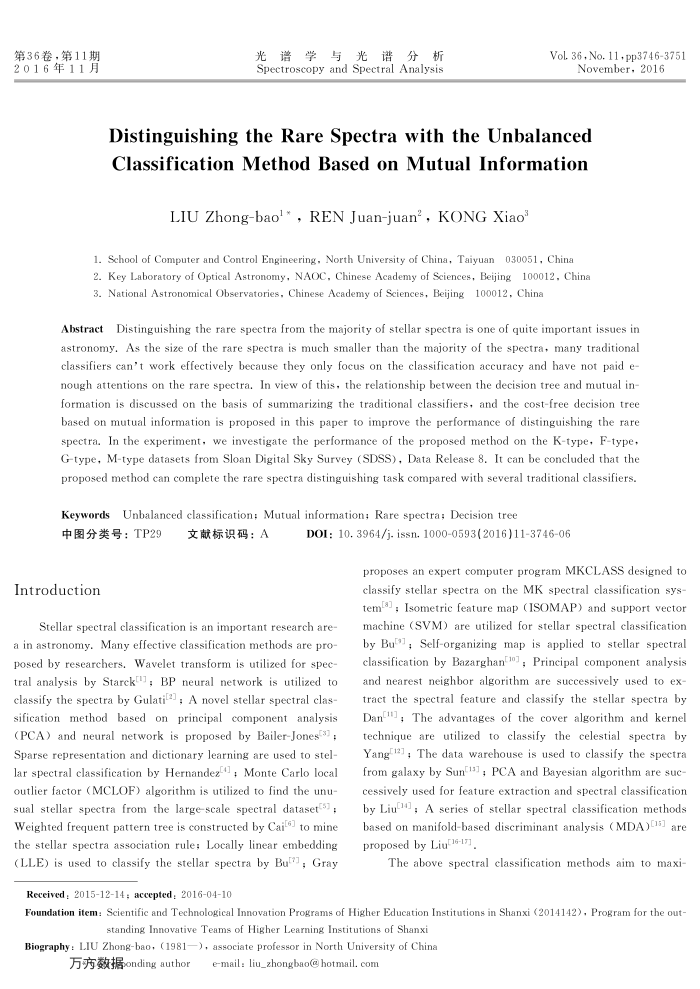利用基于互信息的不平衡分类方法识别稀有光谱
内容简介
 第36卷,第11期 2016年11月
第36卷,第11期 2016年11月光谱学与光谱分析 Spectroscopy and Spectral Analysis
Vol.36,No.11+pp3746-3751
November, 2016
Distinguishing the Rare Spectra with the Unbalanced ClassificationMethodBasedonMutualInformation
LIU Zhong-baol*,REN Juan-juan,KONG Xiao
1. School of Computer and Control Engineering, North University of China, Taiyuan 030051, China
2. Key Laboratory of Optical Astronomy, NAOC, Chinese Academy of Sciences, Beijing 100012, China 3. National Astronomical Observatories, Chinese Academy of Sciences, Beijing100012, China
Abstract Distinguishing the rare spectra from the majority of stellar spectra is one of quite important issues in astronomy. As the size of the rare spectra is much smaller than the majority of the spectra, many traditional classifiers can't work effectively because they only focus on the classification accuracy and have not paid e-nough attentions on the rare spectra. In view of this, the relationship between the decision tree and mutual in formation is discussed on the basis of summarizing the traditional classifiers, and the cost-free decision tree based on mutual information is proposed in this paper to improve the performance of distinguishing the rare spectra. In the experiment, we investigate the performance of the proposed method on the K-type, F-type, G-type, M-type datasets from Sloan Digital Sky Survey (SDSS), Data Release 8. It can be concluded that the proposed method can complete the rare spectra distinguishing task compared with several traditional classifiers.
KeywordsUnbalanced classification; Mutual information; Rare spectra; Decision tree
中图分类号:TP29
Introduction
文献标识码:A
D0I: 10. 3964/j. issn. 10000593(2016)11-3746-06
proposes an expert computer program MKCLASS designed to classify stellar spectra on the MK spectral classification sys tem[), Isometric feature map (ISOMAP) and support vector
Stellar spectral classification is an important research are-a in astronomy. Many effective classification methods are pro-posed by researchers. Wavelet transform is utilized for spec-tral analysis by Starck, BP neural network is utilized to classify the spectra by Gulati[2] , A novel stellar spectral clas-sification method based on principal component analysis(PCA) and neural network is proposed by Bailer-Jones$) ; Sparse representation and dictionary learning are used to stel-lar spectral classification by Hernandez4) ; Monte Carlo local outlier factor (MCLOF) algorithm is utilized to find the unu-sual stellar spectra from the large-scale spectral dataset:5) ; Weighted frequent pattern tree is constructed by Cail6 to mine the stellar spectra association rule; Locally linear embedding(LLE) is used to classify the stellar spectra by Bul?J , Gray
Received: 2015-12-14; accepted: 2016-04-10
machine (SVM) are utilized for stellar spectral classification by Bu*, Self-organizing map is applied to stellar spectral classification by BazarghanfoJ , Principal component analysis and nearest neighbor algorithm are successively used to ex tract the spectral feature and classify the stellar spectra by Daniul, The advantages of the cover algorithm and kernel technique are utilized to classify the celestial spectra by Yang/12], The data warehouse is used to classify the spectra from galaxy by Sunf1sJ , PCA and Bayesian algorithm are suc cessively used for feature extraction and spectral classification by Liu14] , A series of stellar spectral classification methods based on manifold-based discriminant analysis (MDA)(is) are proposed by Liu6-17]
The above spectral classification methods aim to maxi-
Foundation item: Scientific and Technological Innovation Programs of Higher Education Institutions in Shanxi (2014142) , Program for the out
standing Innovative Teams of Higher Learning Institutions of Shanxi
Biography : LIU Zhong-bao, (1981—), associate professor in North University of China
万数据onding author
e-mail : liu_zhongbao@hotmail. com